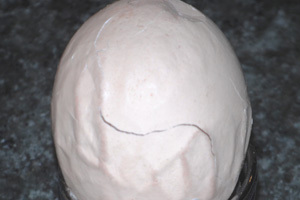Knowing what influences egg quality

Aiming for shell quality starts with understanding how the shell is made and what influences its characteristics. These subjects were covered during the egg quality workshops sponsored by Alltech, which crossed the globe from Malaysia to Moscow and came to roost in Izmir, Turkey on April 26th.
By Wiebe van der Sluis
Environmental variables such as temperature, diet and housing can have an adverse effect on the ability of the bird to synthesise and release the individual components of the egg contents and its protective covering – the shell. Egg producers have to understand the mechanism and how they can influence it. Those who question the need for such detail often use the analogy of the car: “I don’t need to know how the engine was put together – just show me how to drive it”. But the chicken is a living organism and although a specialised knowledge of cell ultrastructure is not necessary, it is a fundamental requirement to understand that the bird responds to conditions in its surroundings and if they induce a stress event then product quality will decline.
In the first lecture of the day, Professor Sally Solomon took the audience on a detailed tour of oviduct structure and function illustrated in a short sequence from a BBC-produced film and using images created by Solomon. Whether the yolk is fertilised or not the processes which occur subsequently are common to both the table and hatching egg, namely albumen production, the synthesis and release of the paired shell membranes and shell formation. The take home message from this introduction to the subject emphasised the role played by thick egg white in the provision of a firm base, capable of supporting the enveloping membrane fibres.
Three phases of mineralisation
The eggshell is a bioceramic and the relationship between the organic and inorganic fractions of the true shell i.e. the calcified aspect, is well documented. The three phases of mineralisation were discussed – the fast phase (formation of the mammillary or basal layer of the shell), the slow phase (the formation of the palisade columns which constitute the bulk of the shell) and the terminal phase during which the cuticle is produced. Each is associated with the presence of a specific protein profile. These proteins derive from a variety of tissue sources and serve a wide range of functions including the control of calcium precipitation. Turkey is primarily a white egg market and so from a distance those physical changes which on the brown egg so clearly implicate stress or disease as causative factors are less visible – but they do exist!
The eggshell is a bioceramic and the relationship between the organic and inorganic fractions of the true shell i.e. the calcified aspect, is well documented. The three phases of mineralisation were discussed – the fast phase (formation of the mammillary or basal layer of the shell), the slow phase (the formation of the palisade columns which constitute the bulk of the shell) and the terminal phase during which the cuticle is produced. Each is associated with the presence of a specific protein profile. These proteins derive from a variety of tissue sources and serve a wide range of functions including the control of calcium precipitation. Turkey is primarily a white egg market and so from a distance those physical changes which on the brown egg so clearly implicate stress or disease as causative factors are less visible – but they do exist!
Slab-sided eggs, wrinkled shells and rough poled eggs were frequently observed, each indicative of delayed oviposition, premature ovulation, infectious bronchitis and mycoplasma, respectively. Others such as the splashed egg and equatorial bulge were discussed with respect to those factors which encourage the bird to retain its egg beyond the anticipated time of oviposition. The sophisticated technology now available in many packing stations ensures that cracked eggs and those with blood spots are removed on line. That having been said, many eggs with ‘pre-cracks’ often escape even such critical examination. This aspect of the course discussed shell morphology. Under normal circumstances the basal layer of the shell is randomly organised, occasionally however the ‘mammillae’ which bond with the shell membranes follow paths of alignment and this arrangement favours the establishment of sites for pre-crack growth should the egg sustain impact damage.
Withdrawing calcium
The structure of the basal layer of the shell was also discussed with reference to the frequent inclusion of non-membrane bound spherical aggregates of calcite and the effects of such morphology on the dual functions of the shell. As the chick develops, it withdraws calcium from the shell and so in addition to accessing this macro-mineral for growth, the chick facilitates pipping by thinning its protective covering. Examination of many eggs at hatching illustrates failure to withdraw calcium from these aggregates supporting earlier hypotheses that bonding with the membrane fibres is a necessary prerequisite for dissolution of the shell.
The structure of the basal layer of the shell was also discussed with reference to the frequent inclusion of non-membrane bound spherical aggregates of calcite and the effects of such morphology on the dual functions of the shell. As the chick develops, it withdraws calcium from the shell and so in addition to accessing this macro-mineral for growth, the chick facilitates pipping by thinning its protective covering. Examination of many eggs at hatching illustrates failure to withdraw calcium from these aggregates supporting earlier hypotheses that bonding with the membrane fibres is a necessary prerequisite for dissolution of the shell.
With respect to the table egg, the inclusion of spherical calcite is a prelude to the formation of a thin shell since these rounded structures do not support the growth of palisade columns. A thin shell would of course also be a disadvantage for the chick in terms of increased water loss. The take home message from this aspect of the course was – shell structure matters and to maintain good shell formation demands in the first instance an awareness of the bird’s environment and the speed with which the pattern of mineralisation can be altered by external variables.
The response of the oviduct to stress (disease or environmental) was illustrated in a sequence of scanning electron microscope images to show that within any one flock of birds, the effect is not ubiquitous – thus some birds will display clumping of the ciliary apparatus which lines the tract, whilst others within the same time-frame demonstrate patches of cell death. Ciliary movement is required for sperm transfer and the absence of cells from the epithelial lining could interfere with shell matrix protein production.
Cause of misshapes
The egg clinic session prompted active discussion on the aetiology of the various misshapes brought along for examination. The extraneous deposits of calcium on several examples were explained as the response to a stress event and the random precipitation of calcium salts onto the now fully formed egg. The oviduct is a muscular organ and the contraction of the muscle onto a forming shell can cause the shell to break, when the muscle tension is released, calcification re-commences – the result – an egg with an equatorial bulge.
The egg clinic session prompted active discussion on the aetiology of the various misshapes brought along for examination. The extraneous deposits of calcium on several examples were explained as the response to a stress event and the random precipitation of calcium salts onto the now fully formed egg. The oviduct is a muscular organ and the contraction of the muscle onto a forming shell can cause the shell to break, when the muscle tension is released, calcification re-commences – the result – an egg with an equatorial bulge.
The egg contents presented with blood spots, meat spots and occasional poorly formed chalazae. The last of these derive from the egg white and serve to anchor the yolk in a central position. Without their support the yolk would be free to move within the albumen mass. The incidence of meat spots was low and they were characteristically of the brown variety. Meat spots derive from the oviducal lining and often comprise an admixture of epithelial cells and blood cells.
Feed to improve shell quality
It is a natural and frequently asked question – what can I feed my birds to improve shell quality? The answer – there is no magic ingredient. As has often been said, the bird’s harmony with its environment is of prime importance. Thus a system which allows the bird to express its normal pattern of behaviour, to avail itself of water and a well balanced diet should encourage the formation of good quality eggs. Unfortunately nature has a way of disturbing this pattern of equilibrium and the course continued with a consideration of those dietary inclusions which by improving both the immune and antioxidant status of the bird have a role to play in enabling protein production both as the bird ages and also in the face of disease.
It is a natural and frequently asked question – what can I feed my birds to improve shell quality? The answer – there is no magic ingredient. As has often been said, the bird’s harmony with its environment is of prime importance. Thus a system which allows the bird to express its normal pattern of behaviour, to avail itself of water and a well balanced diet should encourage the formation of good quality eggs. Unfortunately nature has a way of disturbing this pattern of equilibrium and the course continued with a consideration of those dietary inclusions which by improving both the immune and antioxidant status of the bird have a role to play in enabling protein production both as the bird ages and also in the face of disease.
Scientific literature contains many references to the positive effects of organic trace minerals on parameters such as shell thickness, egg weight and hatchability. The course concluded with a presentation of the results of a layer trial in which the inclusion of Sel-Plex and Bioplex effected an improvement in shell construction from mid-lay until the birds were culled at 72 weeks of age.
This was a highly intensive sequence of lectures and practical’s, the language was new to many and the response from participants ranged from excitement to the feeling one might experience having been run over by a fast moving train. The course was accompanied by a bound set of papers which covered most of the topics discussed during the day and following recovery, could be read at leisure.
Join 31,000+ subscribers
Subscribe to our newsletter to stay updated about all the need-to-know content in the poultry sector, three times a week. Beheer
Beheer








 WP Admin
WP Admin  Bewerk bericht
Bewerk bericht